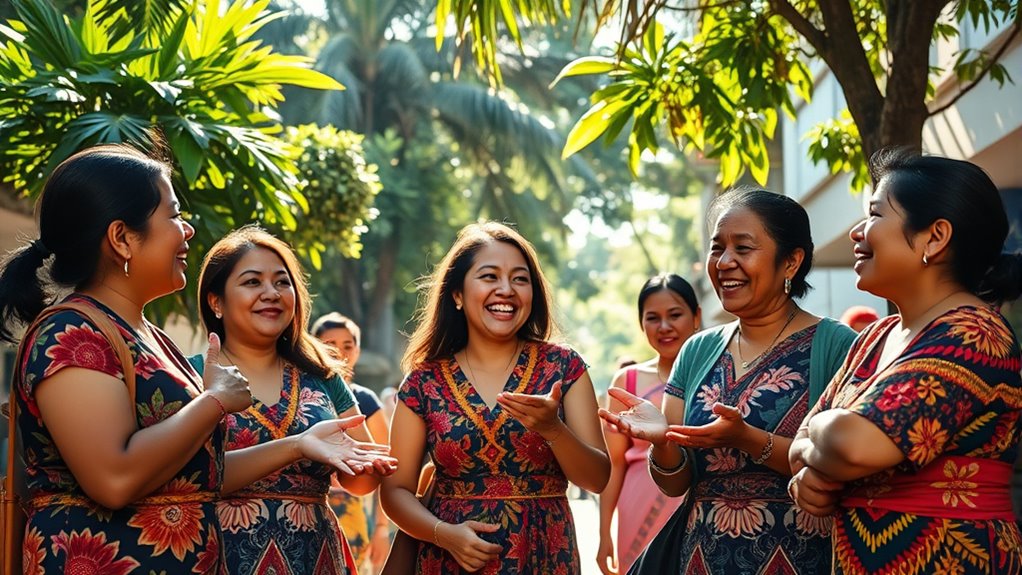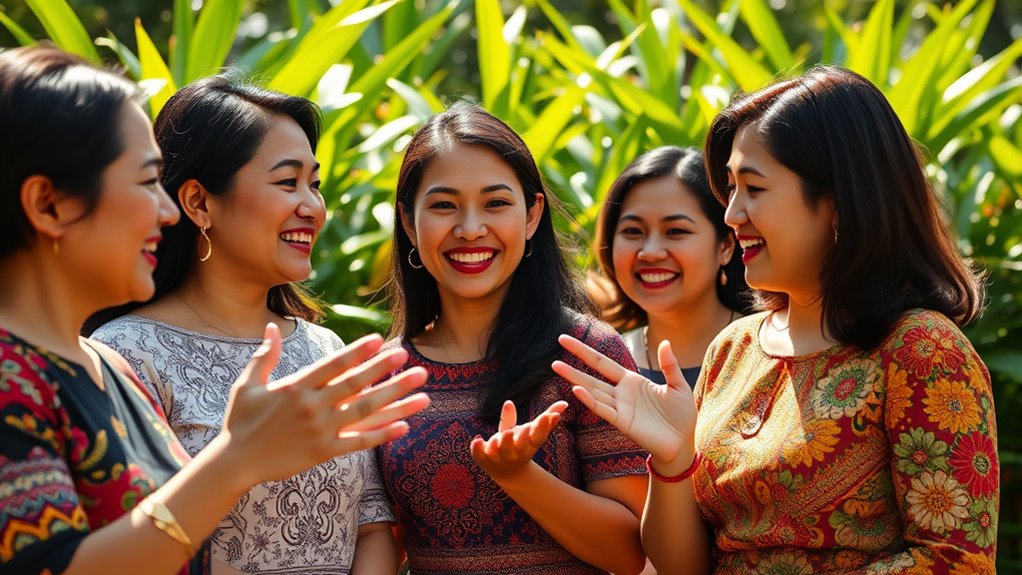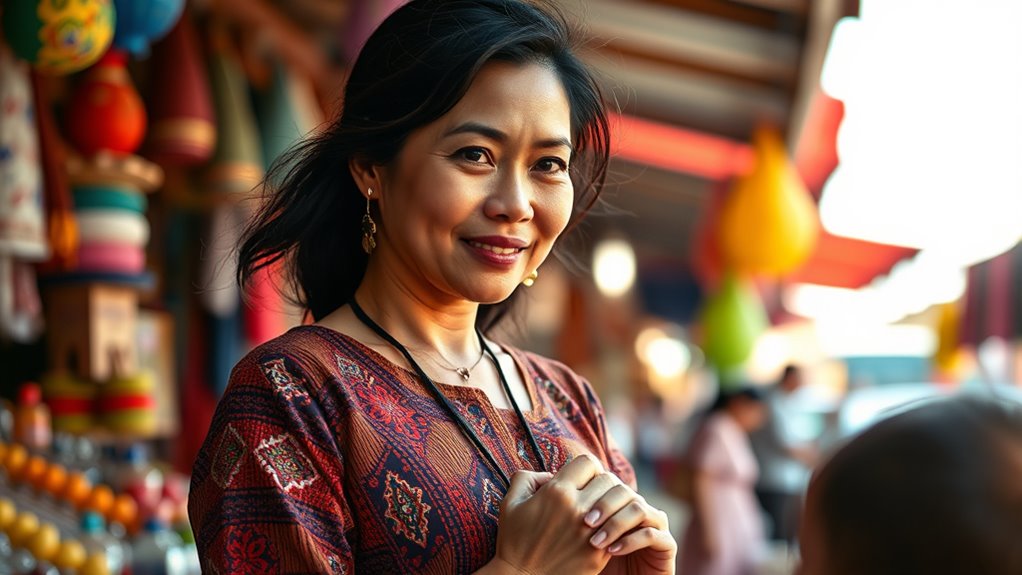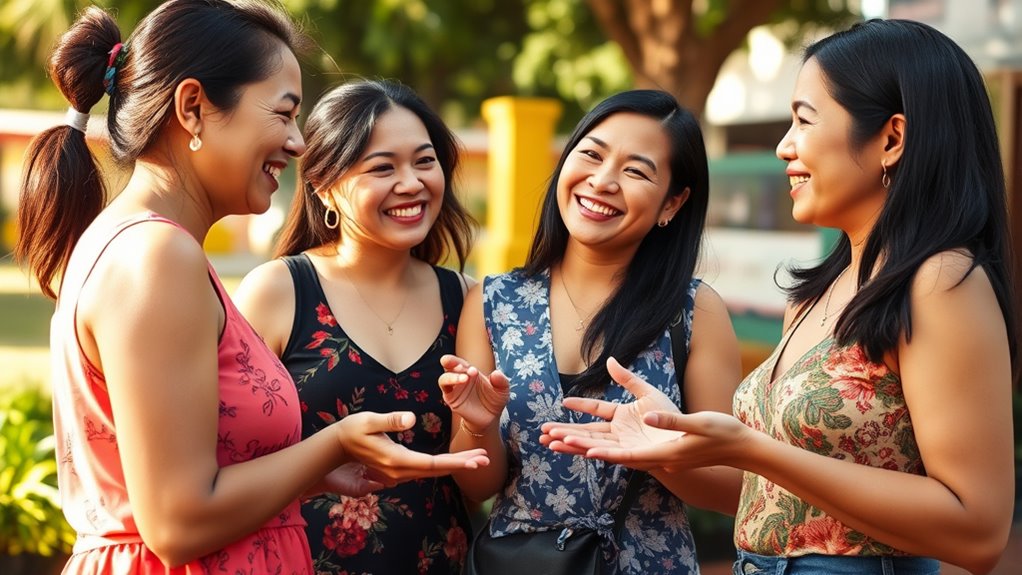Understanding Filipina body language is key to effective communication. In Filipino culture, gestures convey respect and affection, so you’ll notice things like *pagmamano* to honor elders. Pay attention to subtle expressions: smiles reflect happiness, while crossed arms might signal defensiveness. Personal space tends to be about an arm’s length away, especially with strangers. Respectful interactions with elders, using honorifics, are essential. There’s much more to explore about these nuances that enhance connections in every interaction.
Key Takeaways
- Body language comprises approximately 60% of communication in Filipino culture, highlighting its importance in social interactions.
- Gestures like *pagmamano* show respect to elders, while *beso-beso* is a common greeting among women.
- Personal space is generally maintained at an arm’s length, especially with strangers, to establish comfort.
- Subtle facial expressions convey emotions, such as smiles for happiness and raised eyebrows for surprise.
- Respectful communication includes using honorifics like “po” and “opo” when addressing elders or authority figures.
Cultural Significance of Body Language

Understanding the cultural importance of body language is essential if you want to navigate social interactions in Filipino culture effectively. Body language conveys respect, affection, and social cues, accounting for about 60% of communication. Recognizing these nonverbal signals helps you maintain social harmony, preventing misunderstandings and ensuring you respect cultural norms.
For instance, gestures like “mano po” illustrate the importance of respectful interactions, especially with elders. By being aware of body language, you can bridge cultural gaps and foster better international relationships.
Additionally, understanding how Filipinos express opinions diplomatically and maintain modesty in displays of affection enriches your interactions. Ultimately, grasping these nuances can greatly enhance your social experiences in the Filipino community.
Unique Gestures in Filipino Communication

Filipino communication is enriched by a variety of unique gestures that reflect the culture’s values and social norms. One significant gesture is *pagmamano*, where you touch an elder’s hand to your forehead to show respect.
Filipino communication embodies respect through gestures like *pagmamano*, reflecting deep cultural values and social norms.
In social settings, *beso-beso*, or cheek-to-cheek greetings, are common among women. When passing by, lowering your head demonstrates politeness. Simple nods or raised eyebrows can effectively acknowledge someone’s presence.
Hand gestures like lip pointing direct attention without using fingers, while a thumbs up indicates approval. Facial expressions, such as smiling, enhance friendliness, and leaning forward shows interest in conversations.
Understanding these unique gestures will deepen your appreciation of Filipino social interactions and the importance of respect within the culture.
Expressing Emotion Through Subtle Movements

While you mightn’t always hear the words, emotions in Filipino culture often come alive through subtle movements and gestures.
Happiness shines through bright smiles, easily recognized by everyone. Surprise manifests with raised eyebrows, instantly signaling curiosity. Sadness can be seen in downward facial movements, while anger typically tightens facial muscles, reflecting tension. Disgust, though less recognizable, can still be communicated through slight grimaces.
Body posture also plays a significant role; standing upright shows engagement, while slouching suggests disinterest. Crossed arms might indicate defensiveness, and turning away usually signals a desire to avoid conflict.
Understanding these subtle cues enhances your ability to connect with Filipinas, revealing the rich layers of emotion beneath the surface.
The Role of Personal Space and Touch

Personal space and touch play essential roles in communication, especially in Filipino culture, where they’re deeply intertwined with respect and social norms.
You’ll notice that personal space varies; generally, Filipinos prefer to stand about an arm’s length apart, especially with strangers. In crowded public areas, this distance can shrink out of necessity. During initial interactions, maintaining a respectful distance helps establish comfort.
Touch, on the other hand, signals affection among close friends or relatives, yet public displays of affection are usually conservative. Gender plays a role, too—friends of the same gender may walk arm in arm.
Understanding these nuances in personal space and touch will enhance your interactions and foster stronger connections.
Interactions With Elders and Authority Figures

When interacting with elders and authority figures in Filipino culture, you’ll notice that respect is paramount. You’ll likely observe traditional gestures like “mano po,” where you press an elder’s hand to your forehead, symbolizing honor.
Bowing or slightly inclining your head when greeting them further demonstrates your deference. Maintain a humble posture and minimize physical contact to emphasize respect.
In conversation, use honorifics like “po” and “opo” to show politeness. Direct eye contact is often avoided to prevent coming across as aggressive.
Listen attentively and refrain from interrupting, as these behaviors reflect your humility. Overall, these gestures and verbal cues help maintain harmony and uphold the cultural significance of age-based hierarchy in Filipino society.
Non-Verbal Cues in Financial Transactions

Respectful interactions with elders and authority figures set a foundation for understanding non-verbal cues, particularly in financial transactions.
In these situations, watch for the “money sign,” where Filipinos gesture with their thumb and index finger to indicate money. Keep your hands visible; hiding them can create misunderstandings.
Filipinos often communicate indirectly, so pay attention to subtle facial expressions that may signal hesitation or discomfort. Maintaining a respectful distance shows professionalism, while open body language fosters trust.
The Importance of Smiling and Eye Contact

Smiling and eye contact play essential roles in Filipino culture, enhancing social interactions and fostering connections. A smile is more than just a facial expression; it shows hospitality and friendliness, helping to ease tension even in tough situations. You’ll find that Filipinos often smile during celebrations, but also to mask sadness or discomfort. It’s a way to navigate social dynamics and maintain harmony.
While eye contact can convey confidence elsewhere, in the Philippines, avoiding it often signifies modesty and respect, especially towards elders. This subtlety adds depth to interactions, as indirect eye contact is customary.
Ultimately, the combination of smiling and eye contact reflects the warmth and resilience that define Filipino identity.
Maintaining Harmony Through Body Language

While maneuvering social interactions in the Philippines, you’ll find that body language plays a pivotal role in maintaining harmony.
Physical contact between same-gender friends or relatives, like holding hands, expresses affection, while maintaining a respectful distance in public is common. Open postures convey friendliness, whereas closed postures may indicate discomfort.
Subtle facial expressions, such as raised eyebrows for curiosity, enhance communication without confrontation. Using non-verbal cues, like pointing with your lips or gesturing softly, helps avoid direct criticism.
Emotional restraint is valued, especially in formal settings, so you’ll want to choose your words and gestures carefully. Overall, cultural sensitivity and polite body language are essential for fostering positive relationships and ensuring a harmonious environment.
Frequently Asked Questions
How Can I Learn Filipino Body Language Effectively?
To learn Filipino body language effectively, immerse yourself in the culture. Attend local events and observe how people interact.
Practice common gestures, like lip pointing or the “mano po” greeting, to show respect. Engage with locals in social settings and be mindful of their nonverbal cues.
Utilize online resources, like tutorials or cultural blogs, to deepen your understanding. Reflect on feedback to improve your communication skills and enhance your cultural connection.
Are There Regional Differences in Filipino Body Language?
Imagine stepping into a time machine and landing in the Philippines, where regional differences in body language come alive. You’ll notice that many gestures are consistent across the nation, but urban areas might showcase more Westernized cues due to globalization.
In contrast, rural regions may stick closely to traditional expressions. Whether you’re pointing with your lips or beckoning downwards, it’s essential to observe these nuances to understand the cultural context fully.
What Should I Avoid When Using Filipino Gestures?
When using Filipino gestures, avoid standing with your hands on your hips, as it signals anger.
Don’t curl your index finger to beckon someone; it’s considered disrespectful.
Be cautious with lip pointing, as it’s a common directional gesture, not impolite.
Also, steer clear of using the index finger to point—it can come off as rude.
Finally, be mindful of the context when using gestures like the thumbs up; they can be misunderstood.
How Does Gender Influence Body Language in the Philippines?
Imagine a graceful dancer, her movements embodying cultural expectations, as gender profoundly shapes body language in the Philippines.
Women often exude softness, using subtle gestures that reflect modesty. You’ll notice their expressions are more reserved, hinting at a traditional expectation of femininity.
Men, on the other hand, may display bolder, more direct body language.
What Role Does Body Language Play in Filipino Humor?
Body language plays an essential role in Filipino humor, enhancing comedic moments through gestures and expressions.
You’ll notice lip pointing or thumbs up used in jest, while a double eyebrow raise can add a playful touch.
Subtle smiles and avoiding eye contact might indicate mock shyness, making the humor feel relatable.
Exaggerated facial expressions and unique gestures amplify the fun, creating an engaging atmosphere that invites laughter and connection among friends and family.
Conclusion
In understanding Filipina body language, you’ll find it’s like peeling an onion—each layer reveals deeper insights into their culture and emotions. By paying attention to unique gestures, personal space, and non-verbal cues, you’ll navigate conversations with ease and respect. Remember, a warm smile and genuine eye contact can bridge gaps that words sometimes can’t. Embrace these nuances, and you’ll not only connect better but also foster harmony in your interactions with Filipinas.









